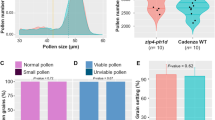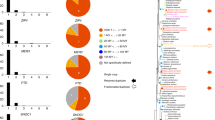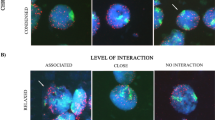Abstract
COMMON wheat, Triticum aestivum (2n = 42), is an allohexaploid with the genomic constitution AABBDD. One of its parents was a tetraploid, like T. dicoccum, with twenty-eight chromosomes and with an AABB genomic constitution. The A, B and D genomes—each of which contains seven chromosomes—were derived from closely related diploid species1. Consequently, there are considerable levels of genetic duplication in T. dicoccum and of triplication in T. aestivum. This is formally recognized by the classification of the chromosome complements of both species into seven homoeologous groups2. Homoeologous chromosomes are genetically corresponding members of different genomes the relationships of which are presumed to stem from their evolutionary origin from the same chromosome of the common progenitor of all three diploid ancestors. Twenty-one bivalents are usually formed at meiosis in T. aestivum and there is disomic inheritance. T. dicoccum has a similar diploid-like pattern of chromosome pairing with the regular formation of fourteen bivalents. Several distinct genetic activities are known to affect the regularity of meiotic pairing of T. aestivum3–5 and it has been inferred that some of these activities are duplicated—being performed at more than one locus5,6. This communication is concerned with the first unequivocal demonstration of such duplication and with the demonstration that different components of the system are responsible for the maintenance of meiotic regularity at low temperatures in different Triticum genotypes.
This is a preview of subscription content, access via your institution
Access options
Subscribe to this journal
Receive 51 print issues and online access
$199.00 per year
only $3.90 per issue
Buy this article
- Purchase on Springer Link
- Instant access to full article PDF
Prices may be subject to local taxes which are calculated during checkout
Similar content being viewed by others
References
Riley, R., in Essays on Crop Plant Evolution (edit. by Hutchinson, J. B.), 103 (University of Cambridge Press, 1965).
Sears, E. R., Res. Bull. Mo. Agric. Exp. Sta., 572 (1954).
Riley, R., Heredity, 15, 407 (1960).
Riley, R., and Law, C. N., Adv. Genet., 13, 57 (1965).
Riley, R., Chapman, V., Young, R. M., and Belfield, A. M., Nature, 212, 1475 (1966).
Feldman, M., Proc. US Nat. Acad. Sci., 55, 1447 (1966).
Riley, R., in Chromosomes Today, I (edit. by Darlington, C. D., and Lewis, K. R.), 57 (Oliver and Boyd, Edinburgh, 1966).
Author information
Authors and Affiliations
Rights and permissions
About this article
Cite this article
HAYTER, A., RILEY, R. Duplicate Genetic Activities affecting Meiotic Chromosome Pairing at Low Temperatures in Triticum. Nature 216, 1028–1029 (1967). https://doi.org/10.1038/2161028a0
Received:
Published:
Issue Date:
DOI: https://doi.org/10.1038/2161028a0
This article is cited by
-
Dmc1 is a candidate for temperature tolerance during wheat meiosis
Theoretical and Applied Genetics (2020)
-
Short periods of high temperature during meiosis prevent normal meiotic progression and reduce grain number in hexaploid wheat (Triticum aestivum L.)
Theoretical and Applied Genetics (2017)
-
Mutant genes affecting higher plant meiosis
Theoretical and Applied Genetics (1985)
-
Cytogenetics of synaptic mutants in higher plants
Theoretical and Applied Genetics (1981)
-
Genes in diploid triticinae compensating for the low temperature regulating gene Ltp in chromosome 5D of Triticum aestivum
Theoretical and Applied Genetics (1979)
Comments
By submitting a comment you agree to abide by our Terms and Community Guidelines. If you find something abusive or that does not comply with our terms or guidelines please flag it as inappropriate.



